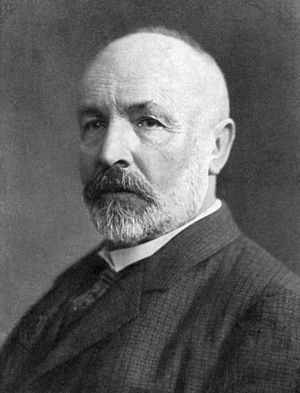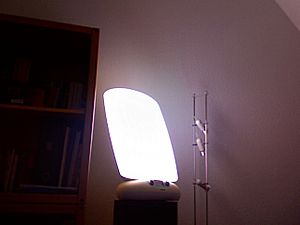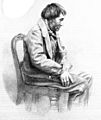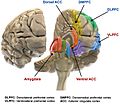Bipolar disorder facts for kids

Bipolar disorder is a mental health condition. It causes big shifts in a person's mood, energy, and ability to do daily tasks. These shifts are called "episodes." People with bipolar disorder can have periods of very high mood and energy (called mania) and periods of very low mood and energy (called depression). Sometimes, they might have both high and low feelings at the same time.
Contents
What are the signs of bipolar disorder?
The word "bipolar" means "two poles." Think of it like having two opposite extremes of energy in the brain. One extreme is a high-energy state called mania. The other is a low-energy state called depression. People with bipolar disorder switch between these two states.
High-energy moods (Mania)
When someone is in a manic state, their brain is very active. They might feel extremely happy or excited, almost like they can do anything. This can make them take big risks or do things they normally wouldn't.
Manic episodes usually last at least a week. They can sometimes go on for several months. After a manic period, a depressive episode often follows.
Signs of mania can include:
- Talking very fast without stopping.
- Thoughts racing quickly from one idea to another.
- Acting without thinking about the results.
- Feeling overly confident or like they are on a special mission.
- Sometimes, they might have psychosis. This means they can't tell what is real and what is not.
Mania can become so strong that it makes it hard for a person to work or be with friends. Remember, not everyone with bipolar disorder has all these signs. Each person is different.
Less extreme high moods (Hypomania)
Hypomania is a milder form of mania. Someone who is hypomanic will have similar signs to mania, but they are not as strong. They might have more energy than usual. They might also not believe that anything is wrong. A hypomanic episode can last from a few days to a few months.
Low-energy moods (Depression)
When someone is in a depressive state, they often feel sad and hopeless. They might lose interest in activities they usually enjoy. They may also feel lonely or want to be by themselves.
Other signs of depression include:
- Feeling worried or anxious.
- Changes in how much they sleep.
- Feeling very tired.
A depressive episode can last from a few weeks to several months. For young people, the first episodes of bipolar disorder are often depressive ones. Because a manic or hypomanic episode is needed to officially diagnose bipolar disorder, some people are first diagnosed with major depression.
How is bipolar disorder diagnosed?
Bipolar disorder can show up differently in each person. It is often diagnosed when people are teenagers or young adults. Doctors have identified a few types of bipolar disorder based on the kinds of episodes a person has:
- Bipolar I disorder: A person with Bipolar I has had at least one full manic episode. They also often have depressive episodes, but a depressive episode is not required for this diagnosis.
- Bipolar II disorder: A person with Bipolar II has not had a full manic episode. Instead, they have had at least one hypomanic episode. They have also had at least one major depressive episode.
- Cyclothymia: A person with cyclothymia has had both hypomanic periods and feelings of depression. These depressive feelings are not as strong as a major depressive episode.
What causes bipolar disorder?
Scientists do not know the exact cause of bipolar disorder. However, they have learned some things about it:
- Genetics: Bipolar disorder can run in families. If one parent has it, there is a good chance their child might also develop it. If one identical twin has bipolar disorder, there is a high chance the other twin will too.
- Brain differences: Studies using MRI have shown that certain parts of the brain that control mood are different in people with bipolar disorder.
- Other events: Sometimes, bipolar disorder can start after a stroke, a brain injury, or certain infections.
How is bipolar disorder treated?

Like many mental health conditions, there are ways to treat bipolar disorder. The most common way is with medications called mood stabilizers. These medicines help control and prevent both manic and depressive episodes. One common mood stabilizer is lithium.
Therapy can also help people manage their symptoms. What works for one person might not work for another. Sometimes, symptoms can return if a person stops taking their medication. This can make bipolar disorder a difficult illness to live with. However, learning about the illness can make it easier. When people understand their condition, they often see that treatment can improve their lives.
Images for kids
-
German psychiatrist Emil Kraepelin first described bipolar disorder in the late 1800s.
-
Singer Rosemary Clooney talked openly about her bipolar disorder, helping others learn about mental illness.
See also
 In Spanish: Trastorno bipolar para niños
In Spanish: Trastorno bipolar para niños










